Click on images to enlarge
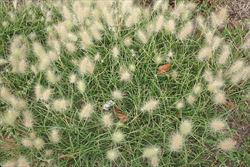
infestation (Photo: Sheldon Navie)
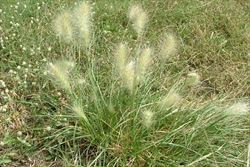
habit (Photo: Sheldon Navie)
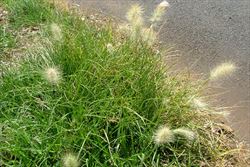
habit (Photo: Sheldon Navie)
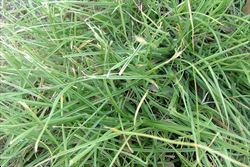
leaves (Photo: Sheldon Navie)
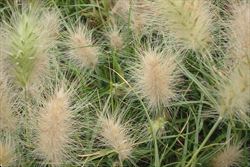
seed-heads (Photo: Sheldon Navie)
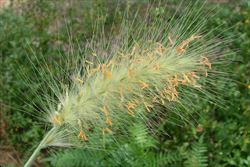
young seed-head (Photo: Sheldon Navie)
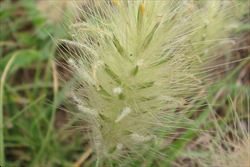
close-up of flower spikelets showing large feathery stigmas (Photo: Sheldon Navie)
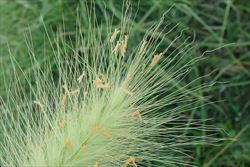
close-up of seed-head showing stamens and long bristles (Photo: Sheldon Navie)
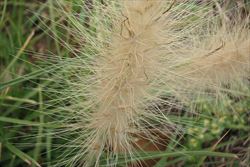
mature seed-head (Photo: Sheldon Navie)
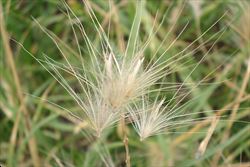
close-up of mature flower spikelets (Photo: Sheldon Navie)
Scientific Name
Cenchrus longisetus M.C.Johnst.
Synonyms
Pennisetum villosum R. Br. ex Fresen.
Family
Gramineae (South Australia)Poaceae (Queensland, New South Wales, the ACT, Victoria, Tasmania, Western Australia and the Northern Territory)
Common Names
feather grass, feathertop, long styled feather grass, long-style feather grass, longstyle feather grass, long-styled feather grass, purple squirreltail grass, white foxtail
Origin
Native to north-eastern Africa (i.e. Eritrea, Ethiopia and Somalia) and the Arabian Peninsula (i.e. Yemen).
Naturalised Distribution
Widely naturalised in southern and eastern Australia. It is most widespread and common in southern Queensland, New South Wales, Victoria, Tasmania, south-eastern South Australia and in the coastal districts of south-western and western Western Australia. Also present in northern Queensland, and in other parts of South Australia and Western Australia. It was also naturalised in the ACT, but has not been collected there for more than 30 years.
Naturalised overseas in some parts of the USA (i.e. California, Colorado, Texas, Georgia and Michigan) and in Hawaii.
Habitat
A weed of pastures, roadsides, footpaths, parks, waste areas, disturbed sites and waterways in semi-arid, sub-tropical and temperate regions.
Habit
An upright (i.e. erect or ascending) or arching and densely tufted long-lived (i.e. perennial) grass usually growing 15-70 cm tall, but occasionally reaching up to 90 cm in height.
Distinguishing Features
- an upright and long-lived grass usually growing only 15-70 cm tall.
- its narrow leaf blades are flat or folded with rough margins.
- its seed-heads are conspicuously feathery and spike-like in appearance (2-12 cm long and 1-2 cm wide).
- these seed-heads turn from pale green or whitish-green to straw-coloured or whitish as they mature.
- their numerous flower spikelets are surrounded by a ring of long whitish coloured bristles (3-7 cm long).
- its mature seeds are shed enclosed within the ring of bristles.
Stems and Leaves
The relatively slender flowering stems (i.e. culms) are slightly bent or upright (i.e. erect) at first. These stems are mostly hairless (i.e. glabrous) and are often branched near the base of the plant. They also often become arched or droop as the seed-heads mature.
Leaf sheaths and leaf blades are mostly hairless (i.e. glabrous), but there is a dense line of hairs (i.e. a ciliated ligule) where they meet and the area surrounding this junction is also sometimes hairy (i.e. pubescent). The narrow leaf blades (6-30 cm x 2-6 mm in size) taper to a point at the apex and are either flat or folded with rough (i.e. finely serrated) margins.
Flowers and Fruit
The conspicuously feathery seed-heads (2-12 cm long and 1-2 cm wide excluding the bristles) are spike-like in appearance (i.e. a spiciform panicle) and oblong or cylindrical in shape. They are pale green or whitish-green in colour when young, sometimes slightly purple-tinged, and always turning straw-coloured or whitish as they mature. These seed-heads are borne singly at the tips of the flowering stems (i.e. culms) and consist of numerous small flower spikelets. The flower spikelets (9-14 mm long) are borne singly or in groups of 2-4 on very short stalks (up to 2 mm long) and are surrounded by a ring (i.e. involucre) of long whitish bristles (3-7 cm long) that give the seed-head its feathery appearance. Flowering occurs mostly during summer, but also from spring through to early winter.
The oblong-shaped seeds (about 3 mm long and 1-1.5 mm wide) are shed enclosed within the ring of bristles (i.e. involucre) and are yellowish-brown or sometimes slightly purplish in colour.
Reproduction and Dispersal
This species reproduces by seed and vegetatively via creeping underground stems (i.e. rhizomes).
Seeds are spread by wind, water, vehicles and also become attached to animals and clothing. The underground stems (i.e. rhizomes) are dispersed during cultivation, as a result of other soil moving activities (e.g. road construction and maintenance), or in dumped garden waste.
Environmental Impact
Feathertop ( Cenchrus longisetus) is regarded as an environmental weed in Victoria, New South Wales, Tasmania and South Australia.
Legislation
This species is declared under legislation in the following states and territories:
- New South Wales: Class 4 - a locally controlled weed. The growth and spread of this species must be controlled according to the measures specified in a management plan published by the local control authority and the plant may not be sold, propagated or knowingly distributed (in a minority of local authority areas). See the New South Wales Department of Primary Industries Noxious Weeds List at http://www.dpi.nsw.gov.au for more detailed information on which local areas are covered in these declarations.
- Tasmania: D - the importation or sale of this species is prohibited and measures to reduce its population in an area, eradicate it from an area, or restrict it to a particular area may be required.
- Western Australia: Unassessed - this species is declared in other states or territories and is prohibited until assessed via a weed risk assessment (throughout the entire state).
Management
For information on the management of this species see the following resources:
- the Foxtail or feathertop grass page on the South Coast Weeds website at http://www.esc.nsw.gov.au/Weeds/index.asp.
Similar Species
Feathertop (Cenchrus longisetus) is similar to fountain grass (Cenchrus setaceus) and swamp foxtail (Cenchrus purpurascens) and relatively similar to mission grass (Cenchrus polystachios), Deenanth grass (Cenchrus pedicellatus) and African feather grass (Cenchrus macrourus). These species can be distinguished by the following differences:
- feathertop (Cenchrus longisetus) is a relatively small long-lived (i.e. perennial) grass
(15-100 cm tall) with relatively broad, oblong-shaped, whitish-coloured
seed-heads. The main stem (i.e. rachis) of the seed-head is angular and the
very long bristles (30-70 mm long) are hairy (i.e. plumose).
- fountain grass (Cenchrus setaceus) is a moderately-sized long-lived (i.e. perennial) grass (50-150
cm tall) with relatively elongated, reddish or pinkish-coloured seed-heads.
The main stem (i.e. rachis) of the seed-head is angular and the long bristles
(up to 25 mm or more) are hairy (i.e. plumose).
- swamp foxtail (Cenchrus purpurascens) is a moderately-sized long-lived (i.e. perennial) grass
(usually 60-100 cm tall) with relatively elongated, purplish-coloured
seed-heads. The main stem (i.e. rachis) of the seed-head is rounded and the
relatively long bristles (15-30 mm long) are hairless (i.e. glabrous).
- mission grass (Cenchrus polystachios) is a large long-lived (i.e. perennial) grass (usually 2-3 m
tall) with very elongated, yellowish or brownish-coloured seed-heads. The main
stem (i.e. rachis) of the seed-head is angular and the relatively long
bristles (4-25 mm long) are hairy (i.e. plumose).
- Deenanth grass ( Cenchrus
pedicellatus) is a moderately-sized short-lived (i.e. annual or
perennial) grass (usually 30-150 cm tall) with elongated, pale
purplish-coloured seed-heads. The main stem (i.e. rachis) of the seed-head is
angular and the relatively long bristles (6-24 mm long) are hairy (i.e.
plumose).
- African feather grass (Cenchrus macrourus) is a large long-lived (i.e. perennial) grass (usually 1-2 m tall) with very elongated, greenish or yellowish-coloured seed-heads. The main stem (i.e. rachis) of the seed-head is rounded and the relatively short bristles (mostly less than 10 mm long) are rough (i.e. scabrous).

